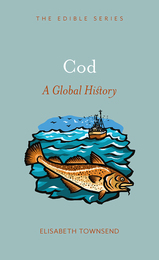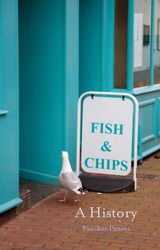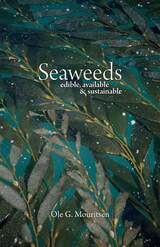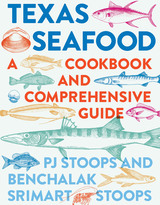
This is the first culinary history of a truly remarkable fish. Elisabeth Townsend follows cod around the globe, showing how its pursuit began with the Vikings, and exploring its influence on human affairs ever since. The book looks at the different ways cod has been caught, cooked, and eaten, often by the descendants of explorers, enslaved people, and traders. Cod examines the fish in the myths and legends of the North Atlantic, the West Indies, South America, West and Southeast Africa, and across the Indian Ocean to the Far East. It is a fascinating journey through cod fact and lore and features delectable historical and contemporary recipes that showcase the myriad ways cod can be consumed.

Double-decker buses, bowler hats, and cricket may be synonymous with British culture, but when it comes to their cuisine, nothing comes to mind faster than fish and chips. Sprinkled with salt and vinegar and often accompanied by mushy peas, fish and chips were the original British fast food. In this innovative book, Panikos Panayi unwraps the history of Britain’s most popular takeout, relating a story that brings up complicated issues of class, identity, and development.
Investigating the origins of eating fish and potatoes in Britain, Panayi describes the birth of the meal itself, telling how fried fish was first introduced and sold by immigrant Jews before it spread to the British working classes in the early nineteenth century. He then moves on to the technological and economic advances that led to its mass consumption and explores the height of fish and chips’ popularity in the first half of the twentieth century and how it has remained a favorite today, despite the arrival of new contenders for the title of Britain’s national dish. Revealing its wider ethnic affiliations within the country, he examines how migrant communities such as Italians came to dominate the fish and chip trade in the twentieth century.
Brimming with facts, anecdotes, and images of historical and modern examples of this batter-dipped meal, Fish and Chips will appeal to all foodies who love this quintessentially British dish.

Fixin' Fish was first published in 1984. Minnesota Archive Editions uses digital technology to make long-unavailable books once again accessible, and are published unaltered from the original University of Minnesota Press editions.
Whether you catch it yourself or buy it, fish can be a delicious, nutritious meal or an experience you'd rather forget. Because fish are delicate and perishable, preserving their fresh-caught flavor requires careful handling. Fixin' Fish provides anglers and fish buyers with helpful techniques, not covered in most cookbooks, for handling, cleaning, preserving, preparing, and buying fish of all kinds. Topics covered include: maintaining the quality of fresh fish, building a smokehouse, smoking, canning, pickling, making fish jerky and caviar, and checking fish for parasites. Sport fishermen will find the section on field dressing and packing especially useful.
Minnesota and neighboring states have an abundance of fish that are usually overlooked as a food source. These underutilized fish, which include suckers, eelpout (burbot), carp, bullheads, herring, and freshwater drum, can be delicious if handled and prepared properly. The special techniques described in this book will help anyone make good use of this inexpensive and tasty source of protein.
Fixin' Fish is published by the University of Minnesota Sea Grant Extension Program. This new edition updates the text and adds information on parasites that can be found on freshwater fish in the Minnesota region.

Tender, plump, and tasty, the blue mussel (Mytiius edulis) is treasured in most of the world's cuisines but strangely ignored in North American cooking. This edible mollusk is naturally abundant on both American coasts and easily cultivated. As over-harvesting makes many other seafoods ever more scarce and expensive, the blue mussel offers an inexpensive and attractive alternative to more costly and wasteful sources of protein. To tempt American palates and draw attention to this remarkably versatile and nutritious seafood, Sarah Hurlburt has written The Mussel Cookbook.
In her entertaining introduction, Hurlburt tells about mussels—how they live, how they saved a bridge from collapsing, why barrels of them appeared in American police stations, how they are farmed in Spain, France, and Holland. Then she offers over a hundred recipes. Whether you are a beginning cook or a devotee of haute cuisine, you will find recipes to match your abilities: simple dishes for the out-of-doors, appetizers, soups and stews, salads, casseroles, main dishes from abroad, and elegant party entrees. From Europe Hurlburt brings back paella, cannelloni, and souffle of mussels, among many others. From Asia come curried and stir-fried mussels as well as the delectable midia dolma. There are a dozen quick-and-easy tricks; there are flamed mussels and mussels Rockefeller. She describes how to clean and freeze mussels, and gives tips on how to use them.
Sarah Hurlburt in collaboration with her husband, Graham, has spent many years learning about the blue mussel. Together they have studied European methods of mussel farming and begun their own experimental Cultivation project in Massachusetts. Ms. Hurlburt's recipes have been featured in the New York Times, the Boston Globe, the Boston Herald American, and Harvard Magazine. Stories about the Hurlburts' adventures with mussels have appeared in the Washington Post, the Cornell Quarterly, and the Marine Fisheries Review. A discussion of their work has appeared in the Congressional Record.


The abundance of seafood available from the northwest Gulf of Mexico includes hundreds of delicious species that are often overlooked by consumers. Celebrating this regional bounty, Texas Seafood showcases the expertise of longtime fishmongers and chefs PJ and "Apple Srimart" Stoops. Readers will find familiar fish like Red Snapper along with dozens of little-known finfish and invertebrates, including tunas, mackerels, rays, and skates, as well as bivalves, shrimps, crabs, and other varieties, many of which are considered “bycatch” (seafood that a fisher didn’t intend to catch), but that are no more difficult to prepare and just as delicious as those commonly found at your local supermarket.
The Stoopses provide a complete primer on sourcing these wild-caught delicacies, with fascinating details about habitats and life cycles as well as practical advice on how to discern quality. Texas Seafood concludes with simple, delectable recipes, many infused with the flavors of Apple’s Thai heritage. Dishes such as Steamed Curried Crab, Crispy White Shrimp, Escolar on a Grill with Green Mango Salad, Cast-Iron-Roasted Shortfin Mako Shark with Rio Grande Grapefruit, and Chicken-Fried Ribbonfish are just a few ways to savor the best of the Gulf.
READERS
Browse our collection.
PUBLISHERS
See BiblioVault's publisher services.
STUDENT SERVICES
Files for college accessibility offices.
UChicago Accessibility Resources
home | accessibility | search | about | contact us
BiblioVault ® 2001 - 2024
The University of Chicago Press









